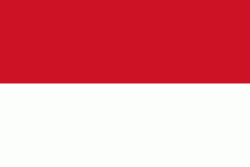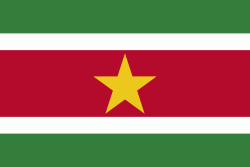Javanese language
Javanese (,, ; basa Jawa, Aksara Jawa: , Pegon: , IPA: ) is a Malayo-Polynesian language spoken by the Javanese people from the central and eastern parts of the island of Java, Indonesia. There are also pockets of Javanese speakers on the northern coast of western Java. It is the native language of more than 98 million people.
Javanese is the largest of the Austronesian languages in number of native speakers. It has several regional dialects and a number of clearly distinct status styles. Its closest relatives are the neighboring languages such as Sundanese, Madurese, and Balinese. Most speakers of Javanese also speak Indonesian for official and commercial purposes as well as a means to communicate with non-Javanese-speaking Indonesians.
There are speakers of Javanese in Malaysia (concentrated in the West Coast part of the states of Selangor and Johor) and Singapore. Javanese is also spoken by traditional immigrant communities of Javanese descent in Suriname, Sri Lanka and New Caledonia.
Along with Indonesian, Javanese is an official language in the Special Region of Yogyakarta, Indonesia.
Javanese is part of the Malayo-Polynesian branch of the Austronesian language family, although its precise relationship to other Malayo-Polynesian languages is hard to determine. Using the lexicostatistical method, Isidore Dyen classified Javanese as part of the "Javo-Sumatra Hesion", which also includes the Sundanese and "Malayic" languages. This grouping is also called "Malayo-Javanic" by linguist Berndt Nothofer, who was the first to attempt a reconstruction of it based on only four languages with the best attestation at the time (Javanese, Sundanese, Madurese, and Malay).
Malayo-Javanic has been criticized and rejected by various linguists. Alexander Adelaar does not include Javanese in his proposed Malayo-Sumbawan grouping (which also covers Malayic, Sundanese, and Madurese languages). Robert Blust also does not include Javanese in the Greater North Borneo subgroup, which he proposes as an alternative to Malayo-Sumbawan grouping. However, Blust also expresses the possibility that Greater North Borneo languages are closely related to many other western Indonesian languages, including Javanese. Blust's suggestion has been further elaborated by Alexander Smith, who includes Javanese in the Western Indonesian grouping (which also includes GNB and several other subgroups), which Smith considers as one of Malayo-Polynesian's primary branches.
Javanese is the largest of the Austronesian languages in number of native speakers. It has several regional dialects and a number of clearly distinct status styles. Its closest relatives are the neighboring languages such as Sundanese, Madurese, and Balinese. Most speakers of Javanese also speak Indonesian for official and commercial purposes as well as a means to communicate with non-Javanese-speaking Indonesians.
There are speakers of Javanese in Malaysia (concentrated in the West Coast part of the states of Selangor and Johor) and Singapore. Javanese is also spoken by traditional immigrant communities of Javanese descent in Suriname, Sri Lanka and New Caledonia.
Along with Indonesian, Javanese is an official language in the Special Region of Yogyakarta, Indonesia.
Javanese is part of the Malayo-Polynesian branch of the Austronesian language family, although its precise relationship to other Malayo-Polynesian languages is hard to determine. Using the lexicostatistical method, Isidore Dyen classified Javanese as part of the "Javo-Sumatra Hesion", which also includes the Sundanese and "Malayic" languages. This grouping is also called "Malayo-Javanic" by linguist Berndt Nothofer, who was the first to attempt a reconstruction of it based on only four languages with the best attestation at the time (Javanese, Sundanese, Madurese, and Malay).
Malayo-Javanic has been criticized and rejected by various linguists. Alexander Adelaar does not include Javanese in his proposed Malayo-Sumbawan grouping (which also covers Malayic, Sundanese, and Madurese languages). Robert Blust also does not include Javanese in the Greater North Borneo subgroup, which he proposes as an alternative to Malayo-Sumbawan grouping. However, Blust also expresses the possibility that Greater North Borneo languages are closely related to many other western Indonesian languages, including Javanese. Blust's suggestion has been further elaborated by Alexander Smith, who includes Javanese in the Western Indonesian grouping (which also includes GNB and several other subgroups), which Smith considers as one of Malayo-Polynesian's primary branches.
Country
-
Indonesia
Indonesia, officially the Republic of Indonesia, is a country in Southeast Asia and Oceania between the Indian and Pacific oceans. It consists of over 17,000 islands, including Sumatra, Java, Sulawesi, and parts of Borneo and New Guinea. Indonesia is the world's largest archipelagic state and the 14th-largest country by area, at 1,904,569 km2. With around 280 million people, Indonesia is the world's fourth-most populous country and the most populous Muslim-majority country. Java, the world's most populous island, is home to more than half of the country's population.
As the world's third largest democracy, Indonesia is a presidential republic with an elected legislature. It has 38 provinces, of which nine have special status. The country's capital, Jakarta, is the world's second-most populous urban area. Indonesia shares land borders with Papua New Guinea, East Timor, and the eastern part of Malaysia, as well as maritime borders with Singapore, Vietnam, Thailand, the Philippines, Australia, Palau, and India. Despite its large population and densely populated regions, Indonesia has vast areas of wilderness that support one of the world's highest level of biodiversity. -
Suriname
Suriname, officially the Republic of Suriname (Republiek Suriname ), is a country in northern South America. It is bordered by the Atlantic Ocean to the north, French Guiana to the east, Guyana to the west, and Brazil to the south. At just under 165000 km2, it is the smallest sovereign state in South America.
It has a population of approximately, dominated by descendants from the slaves and labourers brought in from Africa and Asia by the Dutch Empire and Republic. Most of the people live by the country's (north) coast, in and around its capital and largest city, Paramaribo. It is also one of the least densely populated countries on Earth. Situated slightly north of the equator, Suriname is a tropical country covered in rainforests. Its extensive tree cover is vital to the country's efforts to mitigate climate change and maintain carbon negativity. A developing country with a relatively high level of human development, Suriname's economy is heavily dependent on its abundant natural resources, namely bauxite, gold, petroleum, and agricultural products.
